In the last decades many postal administrations around the world have tested, developed and implemented different franking solutions for shipments, using the issue of variable value stamps. Without doubt this is one of the fields in recent postal and philatelic history with more new ideas and even greater possibilities for the future, and also one of the most unacknowledged amongst philatelists. In this article we'll develop what makes a variable value stamp and its classification.
What are the VARIABLE VALUE STAMPS ? What are the ATMs ?
| The concept of a variable value stamp is very wide, in constant and fast development, and includes different types of postage stamps, hence the difficulty for a precise definition, but in general they could be defined as stamps issued according to the needs of the user.
Thus, the user (customer or postal employee) requests or selects a certain face value and a special machine prints and issues, instantly, the postage stamp. |
Any postage stamp not meeting these requirements cannot be considered a variable value stamp.
The variable value stamps (or automatic variable value stamps) can be described using different criteria, although the main one is possibly according to their conditions of issue and use. They could be also classified, for example, according to the characteristics of the paper when they are printed.
According to the conditions of use of the postage stamp, the variable value stamps can be classified as stamps for immediate use and stamps with indefinite validity (ATMs).
In the first case, they are postage stamps issued by the postal employees for franking postal items handed in at the Post Office window, or by the user with special equipment (self-service vending machines or personal computer), and their use and expiry are immediate. These stamps always include some data (sometimes using 2D matrix codes) about the post office origin or issuing equipment, or even the sender or user, and the date of issue. The date is used as a postmark, so these stamps do not require any type of postal cancellation.
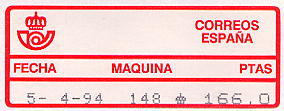 | 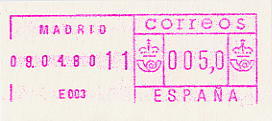 |
|
| 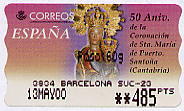 | 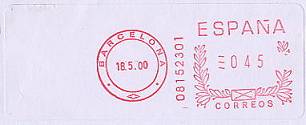 |
| Different types of variable value stamps for immediate use issued in Spain | ||
These stamps are known amongst international collectors by a variety of names: meter stamps, SFS (from the German word Schalterfreistempel or counter stamp), vignettes de guichet, TP label, etc..
In recent years new systems of immediate franking using the Internet and personal computers have been and are being implemented in some countries. These are known as PC franking or PC postage.
(More information: The variable value stamps for immediate use in the world- Spanish version only)
This type of stamp can sometimes be printed on a special security paper, either gummed or self-adhesive, to be affixed, after issue, onto the shipment, or printed directly onto the envelope.
In Spain these postage stamps are known as franqueos mecánicos (mechanical frankings).
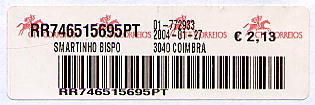 | 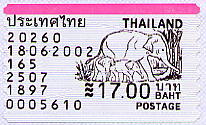 |
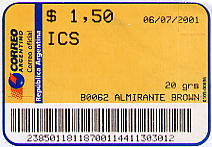 | 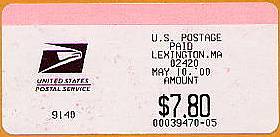 |
| Variable value stamps for immediate use issued in Portugal, Thailand, Argentina and United States | |
On the other hand there are variable value stamps with indefinite validity which we know as ATMs, issued for public use from automatic self-service vending machines or counter machines by the employees in the post offices, depending on the country.
These machines instantly print the face value required, as selected by the user onto a special paper or label, (gummed or self-adhesive), and usually with a preprinted security background, and the resulting stamp has the same characteristics and can be used for franking just as a "traditional" stamp - anytime and anywhere. It has indefinite validity until affixed and postally cancelled.
ATMs can be bought by anyone for use at anytime. Likewise some types of PC-stamps can be used anytime and anywhere, but only by the user or owner of the specific computer software. They are then no longer treated neither as traditional stamps nor ATMs.
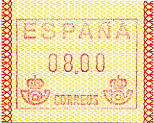 | 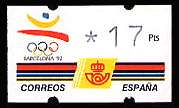 | 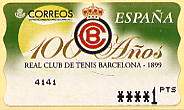 |
| Different types of ATMs issued in Spain | ||
In the first instance, ATMs differ from the mechanical franking because they don't have a date printed on them, which makes for open ended usage, and always requires postal cancellation when finally used for franking.
Having said this, there are exceptions. There are ATM issues which include the date of purchase. Whether a product can be called an ATM is not decided just by the appearance, but the application and the official attitude by the postal administration, concerning the conditions for their use and validity. If the issue can be used anywhere in the country at any time, it's an ATM. If its use, as a stamp, is limited to the date and place of issue, it is not an ATM.
A frequent error is to use the denomination of ATM or variable value stamps by reference to the paper or label. An ATM is not determined by the paper on which it is printed, but the resulting postage stamp.
In the case of Spain, for example, there exists some special printings like adjust and control labels, and these are neither stamps nor ATMs !
| The character of variable value stamp or ATM to a postage stamp can be assigned by the terms of issue and use, and not the characteristics or design of the paper or label where it is printed. |
ATMs started in 1969 with some tests with a vending machine SAFAA-SATAS in Montgeron, France, and are fully recognized as valid stamps by the U.P.U., according to the resolution of the Hamburg Congress in 1984.
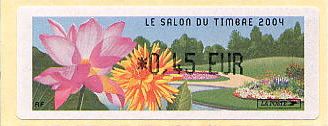 | 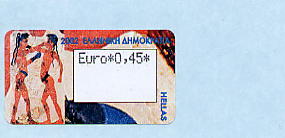 |
 |  |  |
| Different ATMs issued in France, Greece, Hong Kong, Aland and Cyprus | ||
This method of franking is used in many countries world wide. These stamps are known by a variety of names -sello automático, estampilla, etiquette de distributeur, vignette d'affranchissement, machine vending stamp, CVP - Computer vended postage, automatic stamp, francobolli automatici, ...-, but the most widely used term is ATM (an abbreviation of the German term "Automatenmarken" or stamp from an automatic machine).
(More information: The world of ATMs)
| Some usual errors |
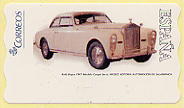 | 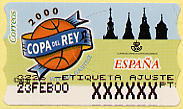 | These are neither variable value stamps, nor ATMs: the first image is a blank label and the second one is an adjust label, both from Spain.
They are not postage stamps. |
 | Despite the same design and different face value, these 2 stamps are not variable value stamps. |
In the same way, some of the world wide definitive series with an identical design and different face values are not variable value stamps.
| The character of variable value stamp or ATM to a postage stamp can be assigned by the terms of issue and use, and not the characteristics or design of the paper or label where it is printed. |
HOW TO COLLECT
HOW TO COLLECT THEM
Variable value stamos or ATMs form an important part of a collection for any country which issues them. Some collectors resist including them in their philatelic collection, and thus fail to recognise their importance in the mail service. ATMs are as much an issue as any of the definitive or commemorative issues of that country.
More and more postal administrations are realising the benefits of issuing ATMs, and the many trials of these issues have proved successful. They will therefore prove to be more and more essential in a stamp collection, as time goes by.
The collecting of ATMs issued by the different postal authorities (currently some 60 postal services) can be the reason for an interesting specialized collection. Some issues can be included in topical / thematic collections. Themes are abundant and include famous people, virgins, sports, boats, trains, cars, motorbikes and so on.
The collecting of ATMs, like any other stamps can take place at different levels :
- The most basic would be to collect only one ATM of each model. In this case, a stamp with the minimum possible value that can be printed on the machine.
- The second level could be the collection of a small value or a complete set of each model and, within the model, of each possible printing variety. The complete set correspond to the basic postal rates used for domestic and the international mail zones. The values which change from time to time with the change of postal tariffs, correspond to the domestic, foreign and overseas rates.
- More advanced levels of collecting may include varieties of the different generations of machines, printings, papers, control and adjust labels, varieties and receipts, ... Like any other aspect of stamp collecting, you can make it as easy or as complex as you wish.
| The collection can be complemented by used ATMs. In this case the most common could be to complete the sets with a used cover franked with an ATM showing the national-inland tariff (for example) for each model and each variety. Registered covers are interesting because up to April 2002, besides the franking ATM they have, the most part of times, a control label too with same paper.
| 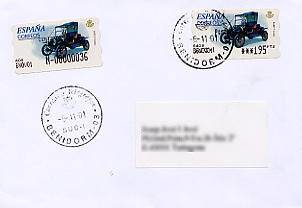 |
|
|
|
The ATM catalogues of the world
Most of the world wide philatelic catalogues include ATM issues along with some basic information, usually in separate sections, as in the case of the French YVERT & TELLIER (Timbres de distributeurs) catalogue or the German MICHEL (Automatenmarken). National catalogues often include such issues under each issuing country.
There are also a few specialized catalogues, including some with little information or authority. Shown below are some of those we believe to be more interesting:
| The German catalogue, Michel Automatenmarken-Spezial 2008-2009, specializes in world wide ATM issues and, at the present time is the leading reference book used by collectors of the subject.
The last edition, in full colour and totally updated, includes ATM issues up to mid 2008. After the departure of Markus Seitz, the Swiss editor, due to disagreements with the publisher, Thomas von Loeper, the German specialist dealer, has joined the editorial team. | 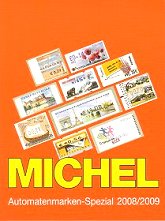 |
| Last edition 2008. Colour, German. 348 pages - 54.80 EUR | |
| Markus Seitz, the author of the earlier editions of the Michel catalogue, between 1994 and 2004, and probably the world's leading ATM specialist, has edited the catalogue Automaten-Briefmarken Ganze Welt - Klassik 1969-1999.
This is a highly recommended specialized catalogue which includes worldwide ATM issues between 1969 and 1999, the period which the author considers as being the 'classic' era for this type of collecting. With a lot of information - it makes essential reading. | 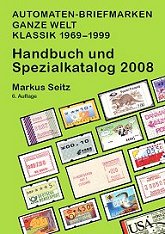 |
| Last edition 2008. Black and white. German. 474 pages - 29.00 EUR | |
| In 2000, the Italian publisher, Flavio Rota, published the second edition of its specialized world wide catalogue of ATM issues, FRANCOBOLLI AUTOMATICI 2000 / World Automatic Stamps Catalogue.
The catalogue shows all the world wide ATM issues from 1969 up to May 2000, along with interesting studies about the ATM distributors, varieties and other items related to this subject. A splendid work for all collectors who want to be introduced to the exciting world of ATMs. | 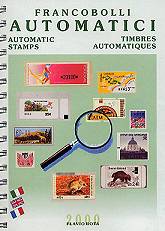 |
| Last edition 2000. Black and white. Italian, French and English. 286 pages - 15.00 EUR | |
| Automaten - Briefmarken Deutschland is a catalogue edited by the German, Rainer Reimund.
This, however, is not a worldwide catalogue, but an interesting study about German ATM issues, between 1981 and 1994. | 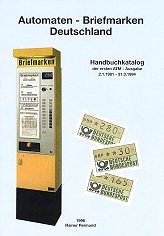 |
| Last edition 1996. Black and white - German. 63 pages |
THIS INTRESTING ARTICLE IS COMING FROM;
http://www.ateeme.net/angles/welcome_a.html



No comments:
Post a Comment